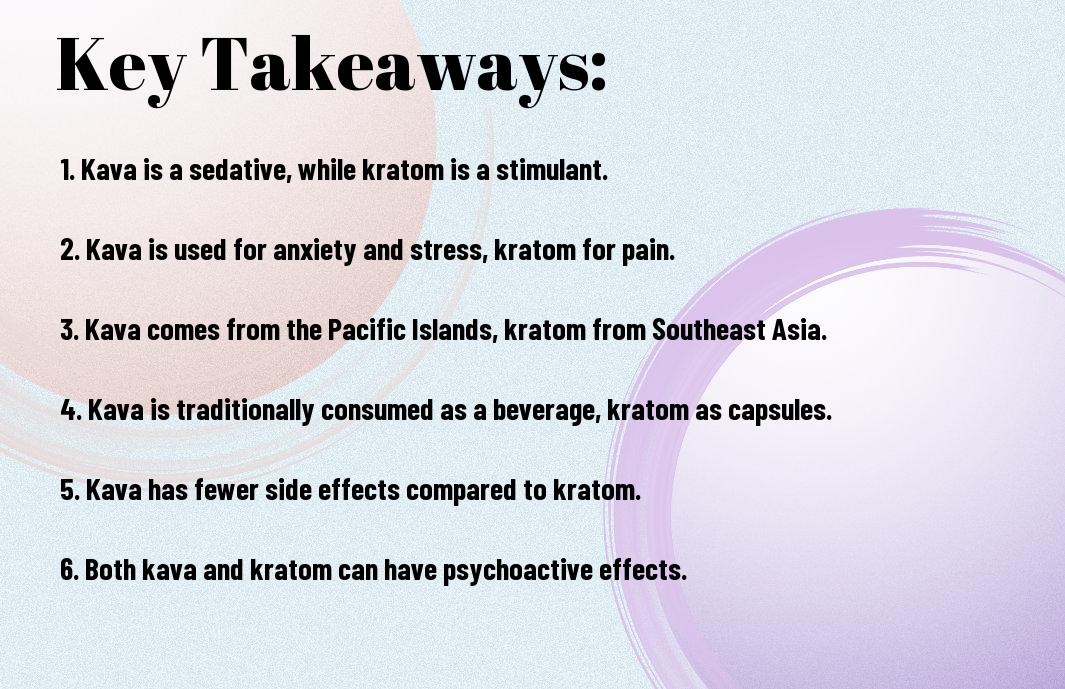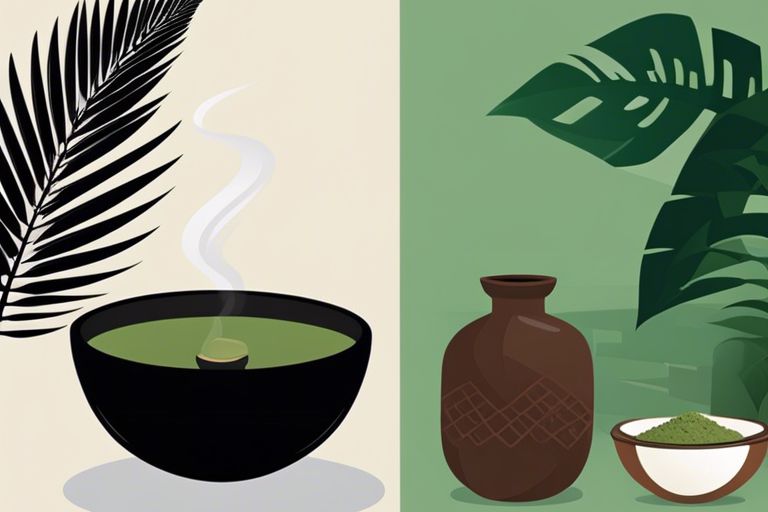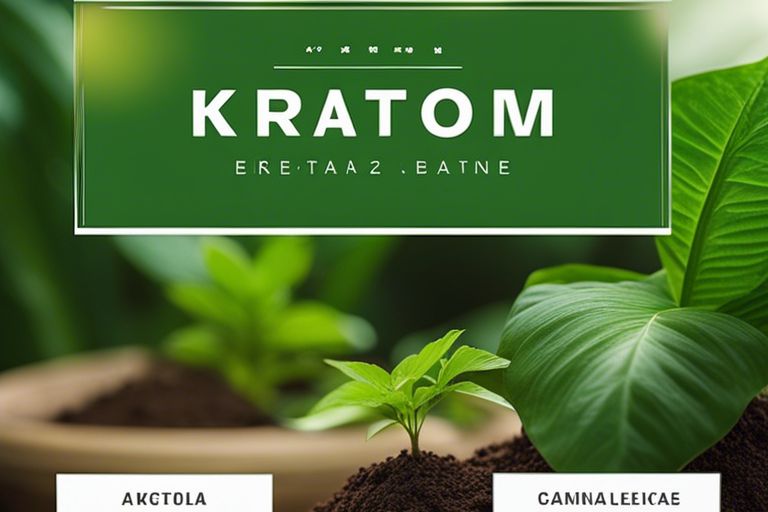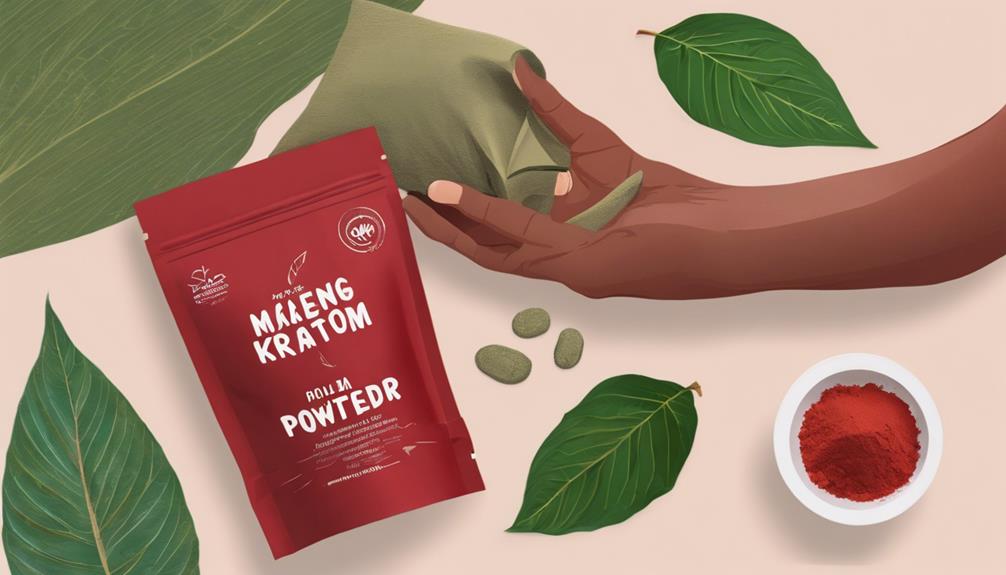Just as kava and kratom gain popularity for their potential benefits, understanding the stark contrasts between these two plants is crucial before incorporating them into daily routines. While both come from traditional backgrounds, kava and kratom differ significantly in their effects on the mind and body. To investigate deeper into the dissimilarities and learn about the safety considerations of kava and kratom, check out How Safe Are Kava and Kratom? – Dr. Raul J. Rodriguez.
Key Takeaways:
- Kava and kratom are different plants: Kava comes from the native plant Piper methysticum, mainly found in the South Pacific islands, while kratom is derived from the Mitragyna speciosa tree, native to Southeast Asia.
- Effects and uses vary: Kava is known for its calming and sedative properties, often used for relaxation and social gatherings, while kratom is popular for its stimulating effects, acting as a mild stimulant or a pain reliever.
- Legality and regulation play a role: While kava is legal in most countries with regulations on its importation and sale, kratom’s legal status varies worldwide, with some regions banning it due to its potential for abuse and dependence.


History and Origins
Kava: Ancient Roots and Cultural Significance
The history of kava dates back thousands of years in the South Pacific region, where it holds significant cultural and social value. The plant is native to the Pacific Islands, where it has been used ceremonially in rituals, social gatherings, and medicinal practices for generations.
The consumption of kava is deeply rooted in Pacific Island culture, where it is used to promote relaxation, social bonding, and a sense of community. The plant has played a crucial role in traditional ceremonies and continues to be a symbol of hospitality and friendship in many Pacific Island societies.
Kratom: A Brief History and Controversies
Briefly, kratom originates from Southeast Asia, where it has been traditionally used for its stimulant and pain-relieving properties. Over the years, it has gained popularity in Western countries as an alternative medicine for managing pain, boosting energy, and alleviating anxiety.
The use of kratom has sparked controversies due to its potential for dependence and abuse. Some countries have even banned the plant due to safety concerns and the lack of conclusive research on its long-term effects.
More research is needed to fully understand the effects of kratom on the body and its potential risks and benefits.
Chemical Composition
While both kava and kratom are natural botanicals with origins in Southeast Asia and the Pacific Islands, their chemical compositions are quite different, leading to varying effects on the human body.
Kava’s Active Compounds: Kavalactones and Flavonoids
For kava, the active compounds responsible for its sedative and anxiolytic effects are known as kavalactones. These are a group of lactone compounds that interact with the brain’s GABA receptors, producing a calming effect. Additionally, kava contains flavonoids, which have antioxidant properties and contribute to its overall wellness benefits.
Kratom’s Active Compounds: Alkaloids and Opioid-Like Effects
For kratom, the primary active compounds are alkaloids, such as mitragynine and 7-hydroxymitragynine. These alkaloids interact with opioid receptors in the brain, leading to pain relief and euphoria. The opioid-like effects of kratom have drawn comparisons to traditional opioids, although kratom’s mechanism of action and overall safety profile differ from pharmaceutical opioids.
The alkaloids in kratom can have a range of effects depending on the dosage and strain of the plant. While some alkaloids may provide pain relief and relaxation, others may lead to stimulant effects at lower doses.
Effects on the Body
Once again, when comparing kava and kratom, it’s crucial to understand how they affect the body differently. Both herbs have distinct properties that lead to various outcomes when consumed.
Kava’s Relaxing and Anxiolytic Properties
For centuries, traditional Pacific Island cultures have used kava for its calming effects. Kava is renowned for its ability to induce a state of relaxation and reduce anxiety. It achieves this by interacting with neurotransmitters in the brain, specifically increasing levels of gamma-aminobutyric acid (GABA), a neurotransmitter that promotes relaxation and reduces stress.
Kratom’s Stimulating and Pain-Relieving Effects
Properties Kratom, on the other hand, is known for its stimulating properties, particularly in lower doses. It can increase energy levels, enhance focus, and even elevate mood. Additionally, kratom possesses pain-relieving qualities that make it a popular choice for individuals seeking natural remedies for chronic pain. Some strains of kratom can also induce a sense of euphoria, making it appealing to recreational users.
Effects: It’s important to note that while kratom can have positive effects such as pain relief and increased energy, it also carries risks. Continuous use of kratom can lead to dependence and withdrawal symptoms, similar to opioids. It’s crucial to use kratom responsibly and be aware of its potential for addiction.
Legal Status and Regulation
Kava’s Legal Status: A Global Perspective
Now, let’s research into the legal landscape surrounding kava. Kava’s legality varies widely across the globe. In many Pacific Island nations, such as Fiji, Vanuatu, and Tonga, kava holds a revered cultural status and is consumed without restrictions. In contrast, some countries, like Canada and Germany, have imposed regulations on kava due to concerns about potential health risks. The United States also briefly banned the sale of kava in the early 2000s, which was later lifted when further research alleviated safety concerns.
Kratom’s Legal Status: Controversies and Bans
Bans on kratom have sparked debates worldwide. Kratom’s legal status is a contentious issue, with some countries, including Thailand and Malaysia, criminalizing its use due to concerns about addiction and its potential for abuse. In the United States, the Drug Enforcement Administration (DEA) has classified kratom as a “Drug of Concern,” leading to regulatory battles between proponents who tout its medicinal benefits and authorities seeking to control its distribution.
This controversy stems from the fact that kratom contains compounds that act on the same brain receptors as opioids, leading to concerns about dependence and addiction. However, proponents argue that kratom can offer a safer alternative for managing chronic pain and opioid withdrawal symptoms. As the debate rages on, the legal status of kratom remains a complex and evolving issue.
Side Effects and Interactions
Many individuals considering the use of kava or kratom may be concerned about the potential side effects and interactions associated with these herbal remedies. It’s crucial to be informed about how these substances can affect your health and well-being.
Kava’s Potential Side Effects: Liver Damage and Interactions
One of the most serious concerns associated with kava is the potential for liver damage. Studies have indicated that excessive or prolonged use of kava may lead to liver toxicity, manifesting as symptoms like jaundice, fatigue, and abdominal pain. It’s important to use kava responsibly and avoid high doses or long-term use to minimize the risk of liver-related issues. Additionally, kava may interact with certain medications, including those metabolized by the liver, potentially affecting their efficacy.
Kratom’s Potential Side Effects: Dependence and Withdrawal
One of the primary concerns with kratom is the potential for dependence and withdrawal symptoms. Individuals who use kratom regularly may develop a tolerance to the drug, leading to dependence over time. Abruptly stopping kratom use can result in withdrawal symptoms such as irritability, muscle aches, and insomnia. It’s vital for users to be aware of the addictive potential of kratom and use it cautiously to avoid developing a dependency.
Interactions: When using kratom, individuals should also be cautious about potential interactions with other substances. Kratom may interact with certain medications, such as antidepressants or painkillers, leading to adverse effects or reducing the efficacy of the drugs. It’s advisable to consult with a healthcare provider before using kratom if you are taking any other medications to prevent harmful interactions.
Based on the potential side effects and interactions outlined above, it is crucial for individuals considering the use of kava or kratom to be well-informed and exercise caution to minimize any adverse effects on their health. It’s always recommended to consult with a healthcare professional before incorporating these herbal remedies into your wellness routine.
Traditional and Modern Uses
Unlike Kratom vs CBD vs Kava – 5 Incredible Differences Discussed, Kava and Kratom have been used traditionally for centuries in different cultures for various purposes.
Kava’s Traditional Ceremonial and Social Uses
Ceremonial: Kava has been consumed for its sedative and relaxing effects in the South Pacific for centuries. It is used in ceremonies to promote relaxation, social bonding, and as a sign of hospitality. Kava bars have become popular in Western countries, providing a social setting for people to enjoy the effects of kava in a relaxed environment.
Kratom’s Modern Uses: Recreational and Therapeutic
Modern: In modern times, kratom has gained popularity for its potential recreational and therapeutic effects. Some people use kratom as an alternative to traditional opioids for pain relief, while others use it for its stimulant properties. It is important to note that kratom can be addictive and has the potential for abuse.
Modern: Additionally, kratom is used by some individuals to alleviate symptoms of anxiety, depression, and opioid withdrawal. However, the FDA has raised concerns about the safety and efficacy of kratom, and more research is needed to fully understand its effects on the body.
Final Words
On the whole, it’s clear that kava and kratom are two distinct substances with unique effects and origins. Kava, with its calming and anxiety-relieving properties, is often used in social settings in the Pacific Islands. On the other hand, kratom, known for its stimulating and pain-relieving effects, originates from Southeast Asia and has gained popularity in Western countries in recent years.
Understanding the differences between kava and kratom is crucial for individuals who are looking to explore natural remedies for various ailments or simply wanting to learn more about these fascinating botanicals. Both substances have their own set of benefits and potential risks, so it’s crucial to research thoroughly and consult with healthcare professionals before incorporating them into your wellness routine.
FAQ
Q: What is Kava?
A: Kava is a plant native to the South Pacific islands, known for its sedative and calming effects. It is often consumed as a drink in social and ceremonial settings.
Q: What is Kratom?
A: Kratom is a tropical tree native to Southeast Asia, valued for its stimulant and pain-relieving properties. It is commonly consumed in various forms, including capsules and powders.
Q: How do the effects of Kava and Kratom differ?
A: While both Kava and Kratom have psychoactive effects, Kava is more renowned for its calming and anxiolytic properties, whereas Kratom is known for its energizing and pain-relieving effects.
Q: What are the main active compounds in Kava and Kratom?
A: The main psychoactive compounds in Kava are kavalactones, which interact with neurotransmitters in the brain to produce their calming effects. Kratom, on the other hand, contains alkaloids like mitragynine and 7-hydroxymitragynine, which bind to opioid receptors in the brain.
Q: Are Kava and Kratom legal and safe to consume?
A: The legal status of Kava and Kratom varies by country, with some places banning or regulating their sale and consumption. While both plants have a long history of traditional use, it is imperative to exercise caution and moderation when consuming them due to potential side effects and interactions with other substances.










